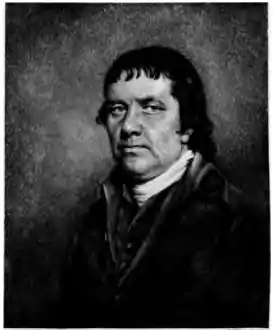John Hazlitt
John Hazlitt (13 May 1767 – 16 May 1837) was an English artist who specialised in miniature portrait painting. He was the eldest brother of William Hazlitt – a major essayist of the English Romantic period, as well as an artist and radical social commentator – and had a significant influence on his career.
John Hazlitt | |
|---|---|
 Self-portrait | |
| Born | 13 May 1767 Marshfield, Gloucestershire, England |
| Died | 16 May 1837 (aged 70) Stockport, Cheshire/Lancashire, England |
| Education | Joshua Reynolds[1] |
| Known for | Miniature painting |
| Spouse | Mary Peirce |
| Parent | William Hazlitt (father) |
| Relatives | William Hazlitt (brother) |
Life


Hazlitt was born in Marshfield, Gloucestershire, the son and first-born child of the Reverend William Hazlitt, a Unitarian minister, and Grace Loftus Hazlitt. After living in Maidstone in Kent, and in Bandon in County Cork, the family moved to America in 1783, living first in Philadelphia and then in Boston.[2]
In Boston, John Hazlitt attempted to found a drawing school with Joseph Dunkerley, but the pair failed to attract enough subscribers. After trying to earn a living as a painter in Salem, he returned to England with the rest of his family in 1787.[3] His parents and younger siblings settled at Wem in Shropshire, but Hazlitt moved to London, where he studied painting under Sir Joshua Reynolds and became reacquainted with William Godwin, a radical philosopher and novelist.[4] In 1788, he exhibited four miniature portraits derived from the work of Reynolds at the Royal Academy, and would exhibit paintings every year until 1819.[5] In May 1789, he married Mary Peirce of Portsea, Portsmouth at St Anne's Church, Soho, and went on to paint several miniature portraits of her.[6] He also painted the portraits of Mary Lamb, Samuel Taylor Coleridge, Joseph Priestley and Edward Jenner. Furthermore, his acquaintanceship with figures such as John Thelwall, Thomas Holcroft, John Stoddart, Charles Lamb and William Godwin meant that it may have been through his brother that William Hazlitt first encountered men who would have an important influence on his career as a writer.[7] When William Hazlitt first travelled to London, he lived with his brother John; and it was John who taught him the art of painting, which he would practise with some success.[8]
In 1815, Hazlitt applied for an associateship at the Royal Academy, but did not receive a single vote in support. It is possible that William Hazlitt's strident criticism of the Academy contributed to this failure. John Hazlitt's response was to return to the alcoholism which had blighted his career.[9]
John Hazlitt remained a political radical throughout his life, and held views which were even stronger than those of his brother.[10] Following his death in 1837, the Gentleman's Magazine published the following obituary:
May 16. At Stockport, in his 70th year, Mr. John Hazlitt, portrait painter, elder brother to William Hazlitt, the eloquent critic and essayist. His connection with Stockport commenced in May 1832, and there are a great many portraits of his execution in that town. He possessed great conversational ability, and was distinguished for the extent of his information and versatility of his powers; but was, like his brother, of an irritable temperament.[11]
Some of Hazlitt's surviving miniatures are held by Maidstone Museum and Art Gallery.[12] William Bentley, an American Unitarian minister, owned many of Hazlitt's works, and it is possible that these were donated to the American Antiquarian Society in 1819.[13]
Notes
- Bate 2004.
- Wu 2008, p. 27; Wu 2006, p. 227.
- Moyne 1970, pp. 34–5.
- Bate 2004. Reacquainted, as the association with Godwin may be traced back to a family friendship established before John's birth. The family of John's mother, Grace Loftus, had been friends with the Godwin family in Wisbech, where Godwin's father was a Dissenting minister in the 1750s; the Reverend William Hazlitt briefly served as minister in the same church a few years later. Howe 1949, p. 31.
- W. C. Hazlitt 1911, pp. 327–8, 337–9.
- W. C. Hazlitt 1911, p. 327; Wu 2008, p. 44.
- Moyne 1970, p. 39. Jones 1989, p. 6.
- Wu 2008, p. 51; Bate 2004.
- Wu 2008, pp. 181–2; Jones 1989, p. 9.
- Wu 2008, p. 181.
- Gentleman's Magazine 1837, p. 668.
- Paulin 1999.
- Moyne identifies a miniature of John Winthrop as being by John Hazlitt: the miniature is in the possession of the American Antiquarian Society, but is listed by them as an anonymous work: Moyne 1970, pp. 35–6. The painting can be viewed on the Society's website.
References
- Bate, Jonathan (2004). "Hazlitt, William (1778–1830), writer and painter", Oxford Dictionary of National Biography. Oxford: Oxford University Press.
- "Obituary". Gentleman's Magazine. 7: 651–670. June 1837. Retrieved 14 October 2012.
- Hazlitt, William Carew (1911). The Hazlitts: an account of their origin and descent. Edinburgh: Ballantyne, Hanson & Co.
- Howe, P.P. (1949). The Life of William Hazlitt. London: Penguin Books (originally published London: Hamish Hamilton, 1922, 1947).
- Jones, Stanley (1989). Hazlitt: A Life. Oxford: Oxford University Press.
- Moyne, Ernest J. (1970). "John Hazlitt, Miniaturist and Portrait Painter in America, 1783–1787". Winterthur Portfolio. 6: 33–40. doi:10.1086/495795. JSTOR 1180522. S2CID 162364279.
- Paulin, Tom (6 June 1999). "Liberty's brightest star". The Guardian. Archived from the original on 23 July 2012. Retrieved 20 August 2012.
- Wu, Duncan (2006). "The Journalism of William Hazlitt (1737-1820) in Boston (1784-5): A Critical and Bibliographical Survey". The Review of English Studies. 57 (229): 221–246. doi:10.1093/res/hgl024.
- Wu, Duncan (2008). William Hazlitt: The First Modern Man. Oxford and New York: Oxford University Press.